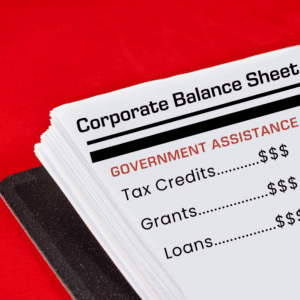As they issue their Forms 10-K for the year 2023, publicly traded companies are required to start disclosing some forms of government financial assistance on their balance sheets for the first time ever. This disclosure– which includes grants and tax credits given to companies in the name of economic development– comes thanks to a new accounting standard for the private sector that follows a disclosure requirement for governments that took effect seven years ago.
Combined, the two accounting reforms, together with Good Jobs First’s Subsidy Tracker and Tax Break Tracker databases, give us a more complete picture of what corporate subsidies cost and who ultimately benefits.

The older rule, Governmental Accounting Standards Board (GASB) Statement No. 77, requires most state and local governments to disclose revenues lost to economic development tax abatement programs in their audited annual financial reports. Though mostly reporting on foregone local property taxes, Statement 77 also captures some corporate income and sales tax breaks used to stimulate economic growth. While the rule doesn’t require any form of company-specific or deal-specific disclosure, knowing the aggregate cost of tax abatement programs has enabled a more robust debate about opportunity costs, especially when abatements undermine school funding.
Now comes GASB’s private-sector sister group, the Financial Accounting Standards Board, or FASB. In November 2021, as an amendment to its version of Generally Accepted Accounting Principles (GAAP), FASB issued Accounting Standards Update No. 2021-10 (Topic 832). It requires businesses to disclose annual transactions with governments, excluding contract work, in their mandatory filings with the Securities and Exchange Commission. (These reports are searchable at the SEC’s EDGAR database.) FASB Standard No. 832-10 aims to give shareholders greater insight into the terms and benefits of such transactions on companies’ financial performance.
Transparent incentives are our bread and butter here at Good Jobs First. So, naturally, we see this FASB update as another positive stride– though by excluding property, sales, and other types of tax breaks it omitted some of the costliest benefits companies receive from the public. However, the effectiveness of both these rules hinges on enforcement and compliance, which can be a challenge.
We have been to this rodeo before. In the same way early government compliance with GASB Statement 77 was uneven, our preliminary scan of how companies are reporting under FASB Standard No. 832-10 indicates a lot of irregularity. Unlike GASB, FASB did not issue any kind of suggested template or format for Standard No. 832-10 reporting.
In the coming weeks, we will publish more blogs on what we are seeing in this very first wave of corporate subsidy disclosures by publicly traded firms.
And don’t forget: Good Jobs First has been publishing deal-specific, company-specific data on subsidy awards since 2010 at our Subsidy Tracker database. Used together, along with local-government disclosures in our Tax Break Tracker database, the new data will empower stakeholders by further illuminating the opaque realm of government incentives and assistance.
Updated April 9th, 2024